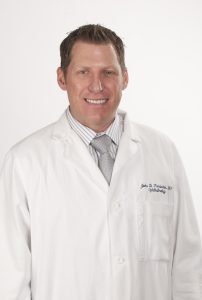Surgeons Use 3D Technology to Reconstruct Man’s Face
| Dec. 8, 2016 | “When I reached up and felt the blood, I knew I’d hurt myself badly. But I had no idea my face had been crushed.”
Sidney Todd III was at his job Jan.13, 2016, checking out oil wells in Union County. As he stepped up on a unit, he slipped on a greasy spot and fell face-first into an engine, breaking his right cheekbone and shattering his eye socket.
“I think I was in shock,” Todd said. “Even though I was bleeding profusely, I was able to hold my face together the best I could to get back to my truck, grab a rag and do my best to apply direct pressure and drive to my office.”

After facial reconstruction surgery in August, Sidney Todd is again enjoying his hobbies that include fishing, riding motorcycles and playing guitar.
Karen, Todd’s wife, was at the office and drove him to the emergency room. She’s a former emergency medical technician and recognized immediately Todd had a serious head trauma. Doctors there took x-rays and sent him to a local specialist who referred Todd to UAMS.
In August, two UAMS College of Medicine surgeons took the lead on Todd’s case: Jennings Boyette, M.D., assistant professor of facial plastic and reconstructive surgery, and John Pemberton, D.O., assistant professor of ophthalmology.
“Fortunately, we’re at an institution where multiple specialists can put their heads together and figure out some of the more complex problems,” Boyette said. “Dr. Pemberton and I recognized this was a particularly challenging case and did the surgery together. We have a great team here at UAMS.”

John Pemberton, D.O., assistant professor of ophthalmology, worked alongside Jennings Boyette, M.D., during Sidney Todd’s reconstructive surgery.
When Todd arrived at UAMS, doctors used his CT scans to begin planning for his surgery to rebuild the injured side of his face. The broken eye socket caused his right eye to regress into his skull, resulting in significant double vision.
“My vision was off by about that much,” Todd said, holding his hands about 12 inches apart.
“We took his CT scans and used a computer to recreate his skull,” Boyette explained. “We made the images three-dimensional and used the good side of his face to superimpose onto the side that had been crushed. Then we used 3D printing technology to print a normal skull based off of Mr. Todd’s images.”
Boyette and Pemberton worked together in a five-hour surgery using the model to reshape his cheek and eye socket. Boyette says they used titanium and molded it to reconstruct the bottom wall and side wall of his eye socket to the exact dimensions based on the CT scans.
“Once we restored the shape and size of the socket, his eye went back to its normal spot and his vision improved,” Boyette said.
Now nearly a year since the accident and three months since the surgery, Todd is back enjoying life as he did before the fall including fishing, riding his motorcycle, playing guitar and spending time with his wife, children and grandchildren.
“Unless you knew it, you can’t tell anything’s happened,” Todd said. “They did an excellent job. I appreciate the concern the doctors and nurses show their patients.”

